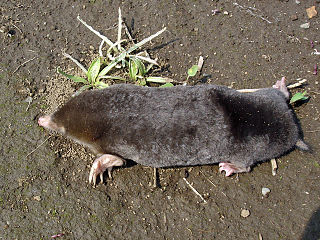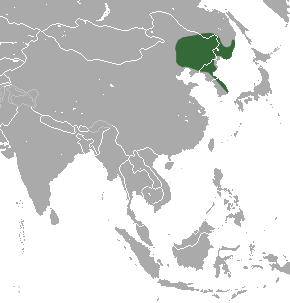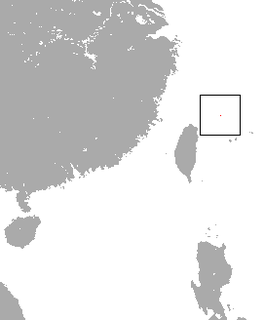
Moles are small mammals adapted to a subterranean lifestyle. They have cylindrical bodies, velvety fur, very small, inconspicuous ears and eyes, reduced hindlimbs, and short, powerful forelimbs with large paws adapted for digging.

Scaffold web spiders (Nesticidae) is a family of araneomorph spiders closely allied with tangle web spiders. Like the "Theridiidae", these spiders have a comb of serrated bristles on the hind tarsi that are used to pull silk bands from the spinnerets. It contains 16 genera and about 300 species, many of which are associated with caves or overhangs. The genus Nesticus is the type for the family and is found throughout the world. The related Eidmannella has speciated considerably in Texas caves and includes some extremely localized species that are considered threatened. One species, Eidmannella pallida, is found in caves and under overhangs, but also in agricultural fields and other habitats away from such restricted areas. The genus Carpathonesticus is found in central Eurasia.

The subfamily Talpinae, sometimes called "Old World moles" or "Old World moles and relatives", is one of three subfamilies of the mole family Talpidae, the others being the Scalopinae, or New World moles, and the Uropsilinae, or shrew-like moles.
Nesticella is a genus of spiders of the family Nesticidae. Most of its species are found in Asia—from Russia to Japan, down to Indonesia and several other islands, including New Guinea—though some species from Africa and South-America are also known. It includes a blind spider, Nesticella marapu.
Nesticella marapu is an eyeless spider from Sumba, Indonesia. It has long legs and weak pigmentation. It is distinguished by all other species in the genus Nesticella by the beak-shaped paracymbium.

The Japanese mole, also known as Temminck's mole, is a species of mole native to East Asia. Its range extends south from Japan. A solitary and diurnal species, it can live for up to 3.5 years in the wild.

The Kano mole is a species of mole native to Taiwan. The specific name kanoana is derived from Tadao Kano, a Japanese naturalist who made the first record of these animals in 1940s.

The Echigo mole is an endangered species of mammal in the family Talpidae. It is endemic to Japan, being found only on the Echigo plain, Niigata prefecture.

Mogera is a genus of mammals in the family Talpidae. Moles in this genus differ from Old World moles in the genus Talpa in having one fewer pairs of lower incisors and in having larger hind premolars in the lower jaw.

The insular mole is a species of mammal in the family Talpidae. It is found in China and Taiwan, where it is also known as the Formosan blind mole. The species was first described by Robert Swinhoe in 1863.
The Kobe mole is a species of mammal in the family Talpidae. It is endemic to a number of islands in central and southern Japan.

The small Japanese mole is a species of mammal in the family Talpidae. It is endemic to Japan. Even though they are extinct in central Tokyo, they are found in the grounds of the Imperial Palace.

The large mole or Ussuri mole, is a species of mammal in the family Talpidae. It is found in China, North Korea, South Korea, and Russia and lives in a long burrow, seldom emerging on the surface of the ground during the day.

The Senkaku mole, also known as the Ryukyu mole, is a species of mammal in the family Talpidae. It was formerly classified as being the only species in the genus Nesoscaptor. It is endemic to the Uotsuri-jima of the disputed territory of Senkaku Islands, also known as the Diaoyutai Islands. It is most similar to the Insular mole of Taiwan and Mainland China.
Nesticella aelleni, is a species of spider of the genus Nesticella. It is endemic to Sri Lanka.
Cyclocarcina is a genus of spiders in the family Nesticidae. It was first described in 1942 by Komatsu. As of 2017, it contains 2 species, one of which has three subspecies, all from Japan.
Speleoticus is a spider genus in the family Nesticidae. Its species are found in Japan and China.









